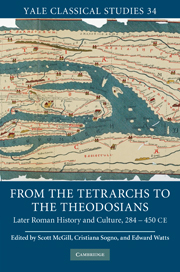Book contents
1 - The unity of the Roman Empire
from PART I - POLITICS, LAW, AND SOCIETY
Published online by Cambridge University Press: 04 August 2010
Summary
While on an embassy to the court of Attila in 449, Priscus of Panium reported that his party encountered an embassy to the Huns from the “western Romans.” These Romans had issues with the Huns that were completely independent of those that had brought Priscus to the lands north of the Danube, and it seems that he regarded them as members of a different state. He referred to his own people as “the eastern Romans,” and, as various sources preserve his words, writes of Rome as a geographical area ruled by multiple “kings.” Priscus's language is scarcely unusual for this era. In a very different context, Anicius Achilleus Glabrio Faustus, who received the great law code commissioned by Theodosius so that he could bring it to the senate at Rome, is described as a man who was honored in “both courts.” Theodosius himself said that he had conceived the project of the code as a gift to “his world,” which, by implication, only included the world ruled by Valentinian III once that emperor had agreed. A generation earlier, the general Arbogast had refused to accept that another Valentinian (Valentinian II) could dismiss him from office on the grounds that he was not responsible for his appointment, while nearly fifteen years before, the uncle of that same Valentinian had not presumed to appoint an emperor to replace his own uncle, Valens, as ruler of the east once Valens had fallen victim to the Goths at Adrianople.
- Type
- Chapter
- Information
- From the Tetrarchs to the TheodosiansLater Roman History and Culture, 284–450 CE, pp. 13 - 32Publisher: Cambridge University PressPrint publication year: 2010
- 27
- Cited by



